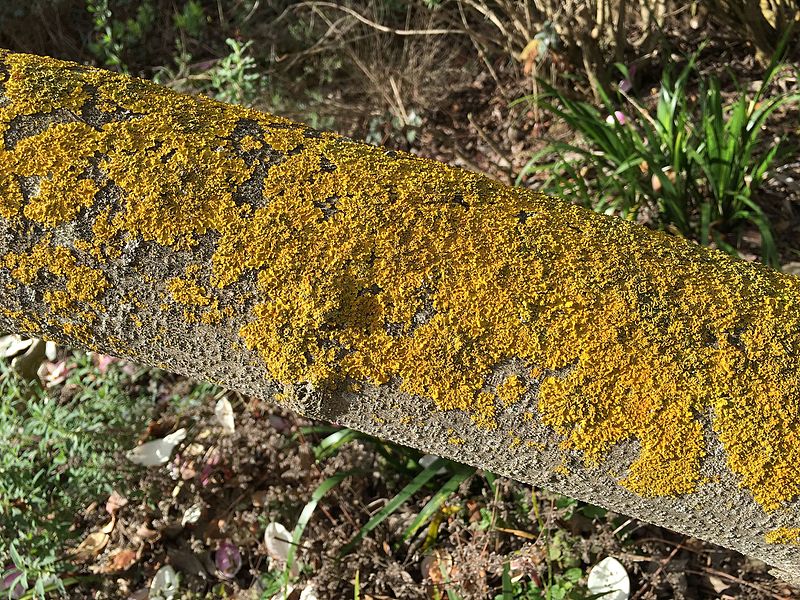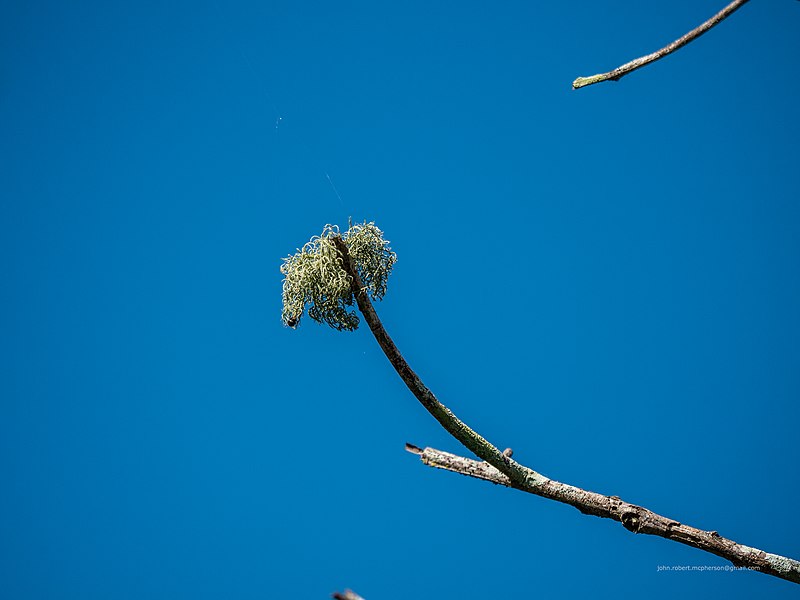Lichen is an important group of plants in the sense that it is two plants in one, that is an alga and a fungus, forming a symbiotic association. The latter constitute the greater part of the lichen body. The organism usually occurs as greyish-green, whitish-green or brightly colored patches on walls, stems and branches of trees, wood and damp wood products, rocks and on the ground. Some may hang on branches of trees and on walls, forming bushy tufts. They may also exhibit some interesting colors, such as yellow, white, brown, grey, red or black. Lichens can grow under extreme conditions and can withstand long periods of dessication.
The organism, in certain cases, may include a form of photosynthetic bacterium called cyanobacterium. All three organisms may actually be found in the lichen.
In this association, the fungus benefits from the algae since it has no chlorophyll hence, it cannot photosynthesize its food. Lichen's fungal part is thus 'fed' by the photosynthesising algal part. Algae benefit from the association because the fungus is better able to see, soak up, and retain water and nutrients than the algae. Also, the fungus gives the befitting lichen shape, and provides the reproductive structures. This kind of relationship between two or more organisms, where both organisms benefit, is known as mutualism or symbiosis.
Lichens are classified based on the nature of the fungus associated. There are two major groups namely Ascolichens and Basidiolichens. In the former the fungal component is an ascomycete, which reproduces by means of ascospores, while in the latter the fungus component is a basidiomycetes, which reproduces by means of basidiospores. Lichens exhibit three different forms of growth patterns and these are
1.) Crustose Lichens: Where the organism covers the substrate (rock surfaces, back of shrubs and trees) like a crust which is hard and granular. Examples include Graphis sp., Lecanora sp.

2.) Fruticose lichens: These are shrub-like forms with much branching which are flat and ribbon-like. Examples include Cladonia rangiferina (reindeer moss which may stand erect), Usnea australis (old man's beard which hang on branches of trees/shrubs).
_(8558189274).jpg)
3.) Foliose lichens: Which form definite flattened leaf like thalli with lobbed margins. They are found growing on rocks, walls, ground and tree trunks attached by means of delicate rhizoids called 'rhizines'. Examples include Physcia millegrana, parmelia.

The type of fungus and alga associated in lichen is always constant. The algae may be scattered on the thallus or occur in one or two layers. Reproduction in lichen may be vegetative, that is, a process by which new individuals arise without production of seeds or spores; asexual which may involve the production and dispersal of diaspores containing fungal and algal cells, for instance, soredia(singular soredium) are small groups of algal cells surrounded by fungal filaments that form in structures called soralia, which occur as greyish coating of powder on the upper surface of the thallus, from which the soredia can be dispersed by wind.
Another form of diaspore is isidia, elongated outgrowths from the thallus that break off for mechanical dispersal. They may also undergo simple fragmentation during which many lichens break up into fragments when they dry, dispersing themselves by wind action, to resume growth when moisture returns. Sexual reproduction has been reported in certain ascolichens and it is the fungus alone that takes part in the process.
ECONOMIC IMPORTANCE OF LICHENS
Lichens play a very important role in soil formation because they are known to disintegrate rocks on which they grow. They thus prepare the substratum for mosses to grow on and subsequently for higher plants. This sequence of colonization is referred to as succession. The following are highlight of their uses;
- Lichens serve as source of food for wild animals and cattle.
- They are used for medicinal and food purposes in certain part of the world, for instance, Cetraria islandica(island moss), Umbilicaria esculenta(in many Korean and Japanese foods);
- Lichens yield very beautiful dyes and tannin used in tanning hides into leather;
- They are used for litmus production; and
- Lichens are also used in the perfume industry.
Reference

Hey @sirpee, nice job. Do you want to break down the long paragraphs into shorter ones for easier reading? You only need to press the 'enter' button just one more time for each.
Thanks for the observation. Done successfully.
Thanks for your contribution to the STEMsocial community. Feel free to join us on discord to get to know the rest of us!
Please consider supporting our funding proposal, approving our witness (@stem.witness) or delegating to the @stemsocial account (for some ROI).
Please consider using the STEMsocial app app and including @stemsocial as a beneficiary to get a stronger support.
Congratulations @sirpee6! You have completed the following achievement on the Hive blockchain and have been rewarded with new badge(s) :
You can view your badges on your board And compare to others on the Ranking
If you no longer want to receive notifications, reply to this comment with the word
STOPDo not miss the last post from @hivebuzz: